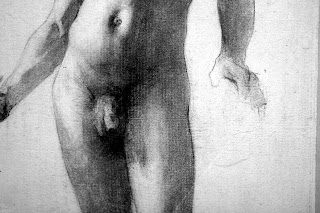****************************************
These beautiful late 19th century academic studies keep popping up on eBay France. I never tire of seeing the painterly techniques of 19th century artists on display. This work is apparently unsigned and undated but what interests me is the use of color, realistic flesh tones, and more importantly, in the artist's technical drawing skills and application of paint to canvas. I wish I were more educated in the 19th century palette for flesh tones. It is interesting how the actual application of paint progresses in the execution of this fine study. If you look very closely at the way the artist has applied the brush strokes you will see a carry over from the 19th century drawing technique:
hatching. Hatching was the technique of applying distinct parallel strokes to model the form, and if necessary, a second set of strokes at the opposite angle on top, to produce cross-hatching. I am sure if you look long enough you will see variations of the other techniques of
graining, allowing the weave of the canvas to carry the shadow areas, and
stumping, the blending of lights and darks. This artist clearly had all the prerequisites for success in his chosen profession.
-----------------------------------------------































































